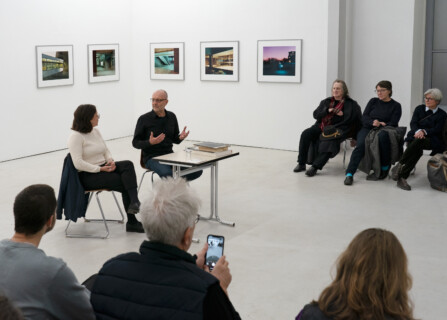In November, the Friends of the GfZK jointly visited artist Matthias Hoch at his exhibition Stadt. Fotografien 1986-92 at Jochen Hempel Gallery at Spinnerei Leipzig.
Matthias Hoch entered into dialogue with Franciska Zólyom and talked about the challenges of his art studies in the GDR and his development towards (colour) photography.
Stadt, 1986
“In the mid-1980s I started taking a greater interest in urban spaces. Unspectacular places, which I photographed in such a way that as little as possible was happening in the pictures. I didn’t need or want any pretext for making a photo: no event, no sun, no shadow, no people. This was incredibly exciting for me, and I felt that it was subversive to translate the structural shell of a city into legible signs, to lift it out of space and time. This procedure was always subjective, because everyone has a different image of familiar spaces and places: this one here is mine. The pictures come about in my head.” (MH, 1990)
During his photography studies Matthias Hoch was already focusing his attention on the urban space. He did not however pursue the most popular approach at the time, using a 35mm camera to take narrative photographs of people. Instead, through his close study of the work of Eugène Atget and Albert Renger-Patzsch, he discovered the world of large-format cameras, which involved a completely different working method. This approach proved conducive to his concentrated search for an aesthetic of everyday life.
The mostly black-and-white photographs in the series show scenes in a city. The pictures are taken from the point of view of a passer-by; the light is diffuse, the sky white. These formal decisions bring out all the more precisely the material qualities of the buildings, the bare branches and the uneven road surfaces.
Nacht, 1987-92
Back in the mid-1980s at the Leipzig Art Academy, black-and-white photography was the order of the day, making it hard for color photography to assert itself. The main reason for this discrepancy was the difficulty involved in mastering the technical processes for the development and enlargement of color photographs without having the right materials at hand. And color photography was frowned upon anyway, viewed as too gaudy, coarse and banal – and in the opinion of its critics not conducive to representing reality.
“Inspired by films like The American Friend (Wim Wenders, 1977), I wanted to finally introduce color into my pictures. Color that would be a completely normal component of the image, an informative addition, not kitsch. Which opened up for me the possibility of representing peculiarly dissonant or achromatic, grayed color constellations as they really appeared.” (MH, 1990)
Matthias Hoch tested this possibility first in night and twilight photos taken in Leipzig and East Berlin. Artificial light sources shape the character of these images, with hues that shimmer between blue, green and magenta, reinforcing the abstract quality of the scenery.
Translated from the German texts of Jochen Hempel Gallery by Jennifer Taylor.
